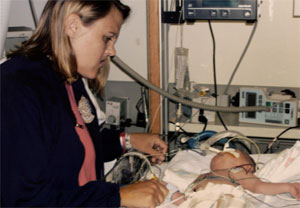 “We’ll be in collections forever,” says Mark Lemacks. The Lemacks family from left: Mark, Jacob, Joshua, Nicholas and Jodi. (Jay Paul/Washington Post)
“We’ll be in collections forever,” says Mark Lemacks. The Lemacks family from left: Mark, Jacob, Joshua, Nicholas and Jodi. (Jay Paul/Washington Post)
RICHMOND – Five months into pregnancy, Jodi Lemacks discovered that her unborn son had a severe heart defect and would require a complex operation as soon as he was born. But the local pediatric heart surgeons didn’t inspire confidence.
One surgeon “had just lost a baby with the same defects,” Lemacks says, “and he only did six of these surgeries a year, which is not a really good number.”
So Lemacks and her husband, Mark, selected a Philadelphia surgeon who was one of the most experienced in the nation at performing the challenging operation. It involved draining the heart of blood while the surgeon reconstructed the aorta, which in a newborn is thin as a string. Even in the best of hands, Joshua had only a 5 percent chance of surviving to the second surgery he would need six months later, several specialists told the Lemackses.
Related Video
The initial surgery in 2003 was a success. But what the relieved parents didn’t realize was that their financial life would be drastically impaired. They ended up with $70,000 in doctors’ bills that their insurer, Anthem Blue Cross and Blue Shield of Virginia, refused to pay – even though it had approved the couple’s choice of surgeons. After the second surgery, they were responsible for $15,000 more. Debt collectors have been calling ever since.
“We’ll be in collections forever,” says Mark Lemacks, who runs his own office-supply business. The family’s credit rating is so low that when they tried to buy a mattress recently, the store would not provide financing.
What ensnared the Lemackses was something called “balance billing,” which occurs when doctors, hospitals or medical labs bill their patients the difference between what they charge and what insurers pay for their services. It comes into play when patients use providers who aren’t part of their insurers’ networks and thus haven’t agreed to prearranged payment rates.
For patients who voluntarily chose an independent caregiver over in-network options, the additional bills, while often unwelcome, are generally considered justifiable. But consumer advocates want the government to protect people who unwittingly end up out of network because of an emergency, such as when they are taken to the nearest hospital after a car crash; or who get an insurer’s permission to see a specialist out of network; or who were unknowingly treated by out-of-network doctors while at an in-network facility. The Lemackses fell into the last two of those three categories.
To these advocates’ dismay, both the House and Senate health-care reform bills explicitly permit balance billing, even though it’s a major contributor to health-related bankruptcies.
Congressional aides say there’s no need to limit the practice, because the pending legislation would require insurers to have enough specialists to ensure patients could get care within their insurers’ networks. Both bills cap out-of-pocket costs for patients seeing in-network providers, and the House version recognizes the financial threat from out-of-network costs by counting a portion of out-of-network costs toward the cap.
Health-policy experts and advocates for people with chronic conditions say Congress could intervene in several ways, as some states have done. Maryland bans providers from balance billing a member of a health maintenance organization for a “covered service” such as emergency care. The state sets rates for how much HMOs must reimburse those providers.
Colorado requires both HMOs and preferred provider organizations to “hold harmless” patients if they are cared for in a network medical facility, as Joshua Lemacks was. As a result, Colorado insurers end up paying the full amount that providers bill or negotiate a compromise rate, according to Kevin Lucia, a researcher at Georgetown University’s Health Policy Institute.
The Lemacks case shows that there are times, even when insurers have broad networks, that patients may decide they need to go outside them.
A Deadly Defect
About one out of every 111 infants is born with some kind of heart defect, according to the American Heart Association. Joshua’s defect, hypoplastic left heart syndrome, was extremely rare and deadly.
The problem was discovered during a routine sonogram when Jodi was pregnant. The baby’s left ventricle was too small to properly pump blood through his body. Making matters worse, the hole between the top two chambers of his heart was closed, pushing blood back into his lungs and damaging them. For infants with a single heart defect, the national survival rate until discharge was about 77 percent at the time. The additional flaw in Joshua’s heart made his situation far more dangerous.
The news shocked the Lemackses, who had two sons born without problems. In their five-bedroom home in a woodsy part of Richmond, the family had enjoyed a comfortable middle-class life. At the time, Mark worked as a salesman in a leadership training company; Jodi, a lawyer, taught two classes as an adjunct professor at the University of Richmond.
 Jodi Lemacks cares for her son Joshua who, born with two heart defects, spent two months in critical care at Children’s Hospital of Philadelphia. (Family Photo)
Jodi Lemacks cares for her son Joshua who, born with two heart defects, spent two months in critical care at Children’s Hospital of Philadelphia. (Family Photo)
Their insurer, Anthem, has an extensive network. But after doing research, the Lemackses decided that Children’s Hospital of Philadelphia would give their unborn son the best chance of survival. The surgeons there typically performed six times the number of these operations as the heart surgeons near Richmond. In addition, their patients with average risk had an impressive survival rate: above 90 percent.
But there was a problem: Although the Philadelphia hospital was in Anthem’s network, the heart surgeon they chose was not. Anthem told the Lemackses that if they wanted the insurer to pay for the surgery, they needed a letter from a network doctor saying it was essential to go to Philadelphia. The director of the fetal heart center at Virginia Commonwealth University submitted a letter recommending the Philadelphia surgeon as “highly capable to perform this procedure with a minimal amount of risk.”
The Lemackses were greatly relieved when they received a letter from Anthem saying it would pay the surgeon based on “in-plan network benefits.” The letter included this line: “When you need health care services, the last thing you want to worry about is your health care coverage.”
The couple assumed the surgeon’s bills would be treated the same as bills from a doctor in their insurer’s network, meaning they would not have to pay more than $3,000, the maximum annual out-of-pocket cost under their individually purchased plan.
But that’s not what Anthem meant. In fact, the insurer had agreed only to reimburse the surgeon – and the other specialists involved in Joshua’s care – at the same rates it paid its in-network doctors, which was less than half what the physicians charged.
Company spokesman Scott Golden defended Anthem’s decisions. “To keep health care costs from rising faster than they already are, we cannot pay doctors who refuse to participate in our network amounts far greater than that paid to doctors who have agreed to provide services to our members for a reasonable fee,” he said in a written response to a reporter’s questions. “Doing so would only encourage doctors to drop out of our networks and balance bill all members.” Anthem declined to discuss whether it adequately explained the payment situation to the Lemackses.
‘Taken To The Cleaners’
Joshua’s first months of life were harrowing. A week before Jodi’s due date, the Philadelphia doctors decided they needed to operate on the baby immediately and performed a Caesarean section. In the weeks after his birth, his heart valve leaked, he fought off infections and nearly died several times. His breathing tube was not removed for five weeks.
Jodi and Mark Lemacks remained in Philadelphia for two months until Joshua was stable enough to leave the hospital. He required a feeding tube and home health care.
Back home in Richmond, the Lemackses found a two-inch stack of letters from Anthem, along with bills from the doctors who had treated their son. “Our first reaction was it was a mistake,” Jodi Lemacks, now 44, says. “Then we started getting calls from people wanting the money, and we wondered what in the world is going on.”
It turned out that most of the specialists who treated Joshua in connection with his surgery – including anesthesiologists, critical-care doctors, cardiologists, a nutritionist and a dermatologist – did not belong to Anthem’s network. The Lemackses had not thought about those doctors’ costs beforehand and say Anthem never brought it up with them.
Nearly every page of bills contained discrepancies between what Anthem was willing to pay and what the Philadelphia doctors were charging. For instance, doctors treating Joshua for one day when he was in critical condition in the hospital billed $2,382; the insurance paid $1,393, leaving the Lemackses owing the balance of $989.
“I used to be an insurance agent,” says Mark Lemacks, who is 42. “My dad is an insurance agent. And I couldn’t understand how we were taken to the cleaners like this.”
Children’s Hospital of Philadelphia and the surgeon who operated on Joshua declined to be interviewed. In a statement, the hospital said it prefers that specialists who practice there belong to the same insurance networks as the hospital does because “what good is a facility without the doctors?” Balance billing problems often arise, the hospital said, when insurers insist on negotiating with hospitals and doctors separately.
‘Wouldn’t Be Alive’
Most health-policy experts say insurers and providers should find ways to resolve their pay disagreements in such cases – or at least do a better job explaining the complex financial issues to consumers ahead of time.
The Lemackses blame Anthem for their predicament, saying the insurer should have reimbursed the doctors’ charges because it approved their decision to go to Philadelphia. They say the doctors offered to reduce their fees if the Lemackses paid promptly.
The couple paid off the bill from the surgeon, which he reduced by two-thirds from its original $12,800. They couldn’t afford to pay off their other medical bills. Even so, they didn’t consider going somewhere besides Philadelphia for Joshua’s second surgery. His health was still so precarious that they didn’t want to risk switching to another surgeon and other specialists.
“Joshua had the best chance of survival there,” says Jodi Lemacks, who now works for Mended Little Hearts, a nonprofit support program for parents of children with heart defects. “We expected they would have big bills, and they agreed to come down off those bills.”
All told, the Lemackses’ out-of-network doctors billed them $159,000 for Joshua’s two surgeries and care while hospitalized. Anthem agreed to pay $74,000, leaving the Lemackses responsible for the remaining $85,000.
The Lemackses are still struggling to pay off that debt. At first, they paid the cardiology and anesthesiology groups $100 a month each. As the family’s premiums paid to Anthem have risen over the years, they’ve cut back those payments, and recently have been sending $75 a month total. They estimate they still owe more than $40,000. Still, they have avoided bankruptcy, which has befallen families with far smaller medical bills.
Meanwhile, Joshua has developed into a mop-haired blond kindergartner with glasses. He’s indistinguishable from other 6-year-olds, except for the scar on his chest and the fact that his lips turn blue when he’s overexerted.
Joshua is “cute, he’s happy, he’s energetic,” his mother says. “He’s a great kid, and he wouldn’t be alive today if we hadn’t gone into major debt by going out of network. This is what health-care reform should be about. It should be about allowing people like Joshua to live and have a happy, healthy life.”






